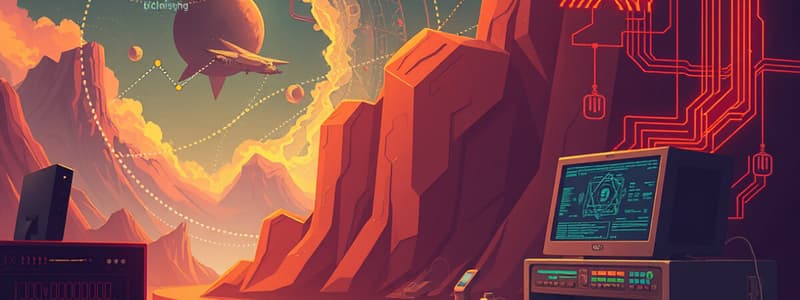Podcast
Questions and Answers
What is a computer?
What is a computer?
An advanced electronic device that processes raw data under the control of instructions, providing output and storing results.
Which of the following is NOT one of the four main functions of a computer?
Which of the following is NOT one of the four main functions of a computer?
- Stores results
- Processes data
- Accepts data
- Generates electricity (correct)
The output of a computer refers to the processed data given after data processing.
The output of a computer refers to the processed data given after data processing.
True (A)
A computer system consists of _____.
A computer system consists of _____.
What does software provide to a computer?
What does software provide to a computer?
Which generation of computers used vacuum tubes?
Which generation of computers used vacuum tubes?
Transistors replaced vacuum tubes in the second generation of computers.
Transistors replaced vacuum tubes in the second generation of computers.
What are input devices?
What are input devices?
What does the Central Processing Unit (CPU) do?
What does the Central Processing Unit (CPU) do?
Which type of memory requires power to maintain stored information?
Which type of memory requires power to maintain stored information?
Match the following components with their categories:
Match the following components with their categories:
Flashcards are hidden until you start studying
Study Notes
Definition of Computer
- An advanced electronic device that processes raw data by following a set of instructions (program).
- Capable of handling both numerical and non-numerical calculations.
Four Main Functions of Computers
- Input: Accepts raw data from users via input devices.
- Processing: Internal operations performed on data as per instructions.
- Output: Generates processed data results, which can be stored for future use.
- Storage: Stores results for later retrieval.
Components of a Computer System
- Computer System Equation: COMPUTER SYSTEM = HARDWARE + SOFTWARE + USER
- Hardware: Physical components (internal devices and peripherals).
- Software: Programs that provide intelligence to hardware.
Generations of Computers
- First Generation (1940-56):
- Used vacuum tubes and machine language.
- Notable computers: ENIAC, EDVAC, EDSAC, UNIVAC-1.
- High electricity consumption, large size, and complex programming.
- Second Generation:
- Replaced vacuum tubes with transistors.
- Used 1/10 the power and generated less heat.
- Development of the first operating systems.
- Third Generation:
- Introduced integrated circuits (chips).
- Shift from small scale to medium scale integrated circuits (MSI).
- Smaller, faster, and more reliable than previous generations.
- Fourth Generation:
- Involved microprocessors and increased data communication capabilities.
- Introduced high-capacity hard disks.
- Fifth Generation:
- Focus on artificial intelligence and applications like voice recognition.
- Innovations in parallel processing and superconductors.
- Future advancements expected in quantum computing and nanotechnology.
Input and Output Devices
- Input Devices: Tools for entering data into the computer, e.g., keyboard, mouse, touchscreen, scanner.
- Output Devices: Tools for displaying processed information, e.g., monitor, printer, projector.
Central Processing Unit (CPU)
- The main component responsible for executing instructions.
- Performs arithmetic and logic operations and is housed in the computer case.
Memory Types
- Primary Memory: Fast storage for programs and data, distinguished as volatile (RAM) and non-volatile.
- Volatile Memory: Requires power to maintain stored data (e.g., Static RAM, Dynamic RAM).
- Secondary Memory: Provides larger storage capacity but is slower to access.
- Virtual Memory: Primary memory stored on secondary memory for efficient operation.
Studying That Suits You
Use AI to generate personalized quizzes and flashcards to suit your learning preferences.




